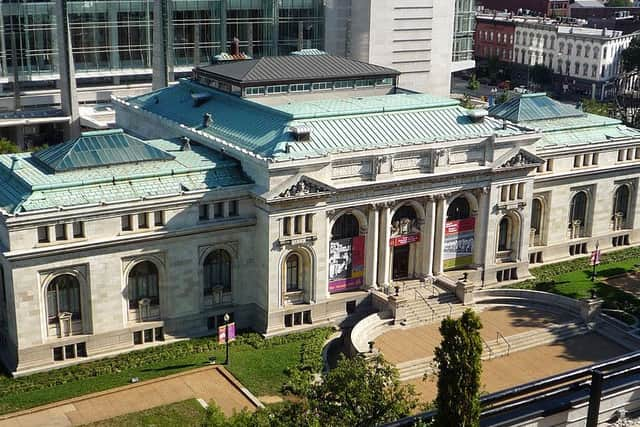The grandest Andrew Carnegie libraries around the world


Here were look at some of the most stunning libraries built in Carnegie’s name after he invested the equivalent of £45m in his belief that education was the key driver of personal success.
Leuven University Library, Belgium
Leuven was one of three cities to receive funding from the Carnegie Endowment for International Peace to rebuild libraries following World War One, with Reims and Belgrade also to benefit.


Advertisement
Hide AdAdvertisement
Hide AdAmerican architect Whitney Warren built Leuven in a Flemish Renaissance style although his building was severely damaged by fire during World War Two with nearly one million books lost. It has since been restored.
The library has a carillon of 63 bells in its tower and holds more than 3 million volumes.
Braddock Carnegie Library, Pennsylvania


Built in a medieval style, Braddock was the first Carnegie library in the United States and opened in 1889.
It quickly doubled in size given its popularity. It wasn’t just books on offer - a billiards table, a music hall, a gym and a swimming pool could all be enjoyed by the public.
A bathhouse in the basement was built in the basement so that mill workers could clean up at the end of their shift. The washing facilities have long gone, but the tiled walls and floors can still be seen.
Central Library, Dunfermline


Around 7,000 people gathered to welcome Andrew Carnegie and his mother to the opening of the philanthropist’s first public library in the world, in his home town of Dunfermline, in 1883.
Such was the interest in the occasion that a half-day holiday was declared for local businesses and factories.
Advertisement
Hide AdAdvertisement
Hide AdThe library, one of 26 public projects funded by Carnegie in the town, was described as “domestic Tudor” by a reporter on duty that day with the three-story building not short of impressive details.
A Gothic-style entrance gave way to separate male and female reading rooms with the library on the upper floor. A smoking room, fitted with oriel windows, could be found on the third with Chateau-style turrets appearing from the roof.


A rising sun motif is engraved above the library’s main entrance with the words “Let there be Light”.
Mount Vernon Square, Washington DC
Designed in the Beaux-Arts style, this is perhaps the most elaborate of all the Carnegie libraries, with angels, cherubs, cornicing and clusters of engravings vying for attention.
Opened in 1902, it was designed by the New York firm Ackerman & Ross amid a growing trend for public buildings to executed in the French style.
Inside the main foyer, the names of Shakespeare, Newton and Plato are among those which loom down over visitors. The inscription University for the People also set the tone.


It was used as a library for over 70 years before it became too small for its collection. It was latterly used as an events venue.
Advertisement
Hide AdAdvertisement
Hide AdNow, Apple Inc plan to use the building for a new store with architect Foster + Partners working on the designs.
Springfield City Library, Massachusetts
Pink granite, white Vermont marble and a green tile roof came together to created the imposing but elegant Italian Renaissance-style library in the heart of Springfield.
Such was the enthusiasm for the project of the towns people, who contributed $155,000 to the project, that Carnegie twice increased his own donation.
A cable car system was devised to move books from the old library to the new Carnegie building, with the entire move in 1912 taking just eight days.
Key features include the second-floor Rotunda, called the library’s “centre court”, which includes a series of Corinthian columns and an amber-tinted glass dome.
The head of the ancient goddess of wisdom, Minerva, and a bronze bust of Andrew Carnegie can also be found.
Thames Borough Library, Thames, New Zealand
Carnegie promised £2,000 to Thames Borough Council for the creation of a public library in 1902.
Advertisement
Hide AdAdvertisement
Hide AdThree years later, a grand Victorian building designed by architect J Currie opened to the townspeople with 4,000 books now at their fingertips.
Every room had a grate for an open fire with archways, huge sash windows and double-height skirting boards giving the impression of an exceptionally grand residence.
It is now a Heritage class 2 building in New Zealand and one of only three of the country’s 18 original Carnegie libraries to remain.
A state-of-the-art temperature controlled extension was added in 2014.
Central Library, Edinburgh
Designed in 1887 by the renowned architect Sir George Washington Browne and opened in 1890, Edinburgh Central Library is still considered an outstanding example of the public library.
Delivered in the French Renaissance style, the building drops three levels below George IV Bridge and sits two storeys above street level.
It features polished ashlar stones, elaborately carved panels and ornate sandstone carvings on the lower floors.
Advertisement
Hide AdAdvertisement
Hide AdIt was considered ahead of its time given its use of electric lighting, the employment of female staff and the inclusion of a children’s library in the main building.
Carnegie’s £50,000 donation for the project was matched by Edinburgh publisher Thomas Nelson, who was keen to create an accessible building which the public could enjoy.
